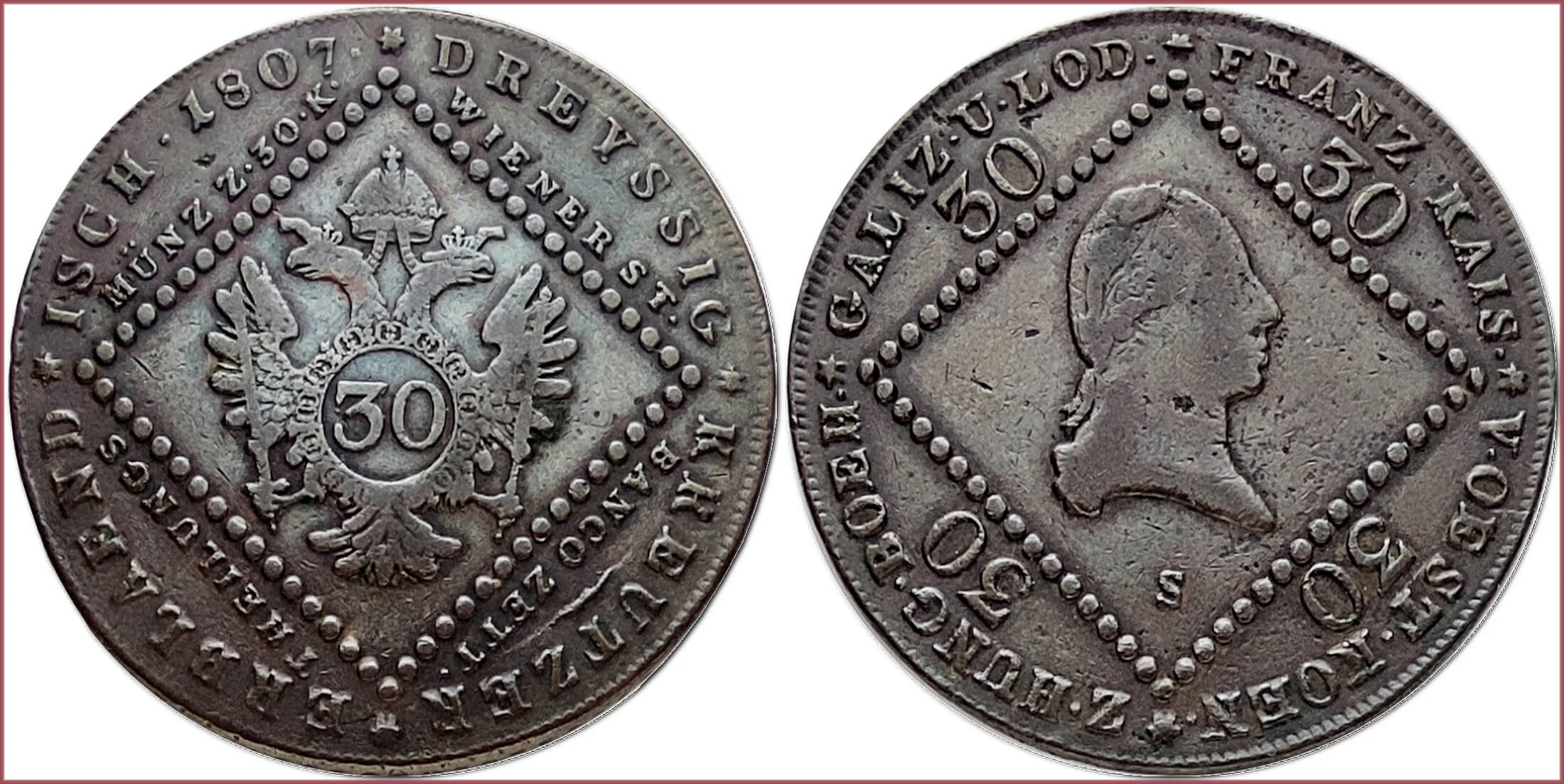KREUTZER: COIN OF AUSTRIAN EMPIRE
30 kreutzer, 1807: Austrian Empire
Ruler: Francis II (German "Franz II") — the last Holy Roman Emperor and, as Francis I, the first Emperor of Austria (1804-1835).
DREYSSIG KREUTZER - ERBLAEND - ISCH - 1807: thirty kreutzer of Hereditary Lands, 1807.
Wikipedia: "The Erblande (Hereditary Lands) of the House of Habsburg formed the Alpine heartland of the Habsburg monarchy. They were the hereditary possessions of the Habsburgs within the Holy Roman Empire from before 1526. The Erblande were not all unified under the head of the dynasty prior to the 17th century. They were divided into several groupings: the Archduchy of Austria, Inner Austria, the County of Tyrol and Further Austria".
WIENER ST - BANCO ZETT - THEILUNGS - MÜNZ - Z - 30 K (Wiener Stadt-Banco-Zettel Teilungsmünzen Zu 30 Kreutzer): a coin equal of 30 kreutzers note of the Vienna City Bank /coin was issued from copper during the crisis instead of the usual silver coin/.
Coat of arms of Austria as part of the Austrian Empire (denomination "30" on the eagle's chest).
FRANZ - KAIS - V - OEST - KOEN - Z - HUNG - BOEH - GALIZ - U - LOD (Franz Kaiser von Österreich, König zu Hungarn, Böhmen, Galizien und Lodomerien): Francis Emperor of Austria, King of Hungary, Bohemia, Galicia and Lodomeria.
Portrait of the emperor in a rhombic frame.
30 - 30 - 30 - 30.
Mintmark "S" (German "Schmllnitz", mint of Smolnik in Slovakia).
Mintage: 15.787.000.
- Copper: 37 mm - 16.86 g
- Reference price: 13$
COIN KREUTZER — WHERE & WHEN (coins catalog: by names & emitents)
- AUSTRIA (AUSTRIA, HABSBURG MONARCHY + AUSTRIAN EMPIRE; 18th-19th centuries): kreutzer = 1/60 gulden
- HUNGARY (HABSBURG MONARCHY; 18th century): kreutzer = 1/60 gulden (forint)
- GERMAN STATES (BADEN, HESSEN-DARMSTADT, MAINZ, PRUSSIA...; 18th-19th centuries): kreutzer
- SWISS CANTONS (OBWALDEN, ST. GALLEN...; 18th century): kreutzer = 1/120 thaler...
About the name of the coin kreutzer: everything here is simple — the coin is named after the plot of the earliest kreutzers of the 13th century. It is about the image of the cross (German "Kreuz").
It is much more difficult to find a rational explanation for the following phenomenon: some coins of this type contain the designation of the denomination in the format "Kreutzer" instead of the more common "Kreuzer". It was not possible to find regularities in the use of this or that variant of writing the denomination.
By the way, in addition to the coin denominations kreutzer and kreuzer, numismatics also distinguish the Hungarian krajczár and the extremely rare Swedish creutzer.

